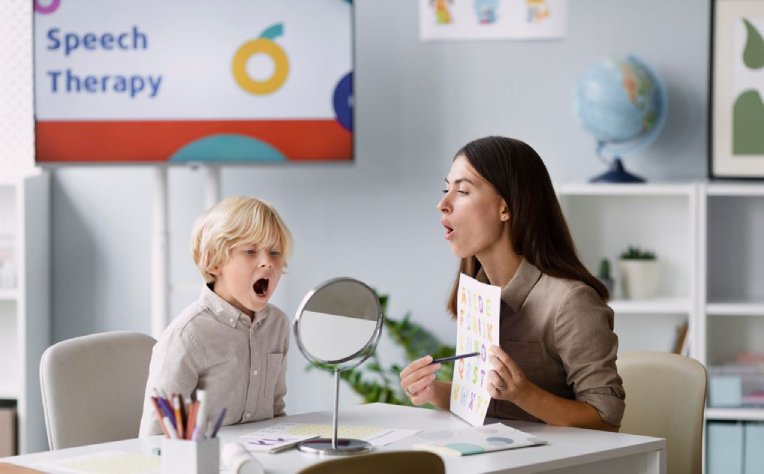Every child embarks on a remarkable journey of language development, commencing right from the moment of birth. Over the course of approximately two to three years, infants progress from making gentle cooing sounds to constructing meaningful phrases. Recognizing the appropriate time to consider speech and language therapy for your child is crucial.
Understanding speech and language milestones from 6 months to 2 years can help you gauge their development and identify potential areas of concern. We are specifically mentioning these time periods as most of the speech and language delays can be identified by this point.
6-12 Months: Early Communication Skills
Between the ages of 6 to 12 months, your child begins their journey of communication. They might start by babbling simple sounds like “ba-ba” or “ma-ma.”
By the end of this period, they should be responsive to their name, make eye contact, and show interest in familiar voices and sounds. Additionally, they may attempt to mimic simple sounds or gestures, such as waving bye-bye.
12-18 Months: Vocabulary Expansion
Around 12 to 18 months, your child’s vocabulary starts to grow. They may begin saying their first words, like “mama” or “dada.” By 18 months, they should have a handful of words in their repertoire and be able to follow simple one-step directions.
At this stage, it’s common for their pronunciation to be imprecise, but they should be steadily improving.
18-24 Months: Sentence Building
From 18 to 24 months, your child’s language development takes a significant leap. They’ll likely start combining words into two-word phrases or short sentences, such as “more juice” or “big ball.”
Their understanding of language also improves, allowing them to follow more complex instructions. While pronunciation may still be developing, their speech should be becoming clearer.
If you notice that your child isn’t meeting these milestones within the suggested timeframes, or if they exhibit signs like stuttering, limited vocabulary, difficulty understanding, or social withdrawal, it’s advisable to consult with a Speech-language Pathologist (SLP).
Speech-language Pathologist (SLPs) are skilled in assessing and addressing these concerns, ensuring that your child receives the necessary support to thrive in their language development journey.
Speech and Language Therapy: Here are some other red flags that may suggest a need for it

Stuttering
Stuttering is a speech disorder characterised by disruptions in the normal flow of speech. If you notice your child frequently repeating sounds, syllables, or words, or if they seem to struggle when speaking, it’s a potential red flag.
Early intervention can help address stuttering and improve your child’s fluency in communication.
Limited Vocabulary
A limited vocabulary can hinder effective communication. If your child is significantly behind in developing their vocabulary for their age, it may indicate a language delay.
An SLP can help expand your child’s vocabulary and language skills, enabling them to express themselves more fully.
Pronunciation Issues
Pronunciation difficulties are common as children learn to speak, but if these issues persist beyond a certain age, it could be a concern.
If your child constantly has trouble pronouncing specific sounds or words, it’s advisable to consult with a Speech-language Pathologist who can work with them to improve their articulation.
Difficulty Understanding Simple Instructions
If your child struggles to comprehend and follow simple instructions appropriate for their age, it may indicate a receptive language disorder.
This can impact their ability to learn and interact effectively. An SLP can assess their receptive language skills and provide guidance on improving comprehension.
Social Withdrawal
Social withdrawal or shyness in social situations can be a sign that your child is having difficulty with communication. If they tend to be excessively quiet, avoid interactions, or have trouble engaging with peers, it’s essential to address these social challenges early.
A Speech-language Pathologist can help your child develop the social communication skills needed for successful interactions.
Identifying and addressing these red flags promptly can make a significant difference in your child’s speech and language development. Seeking the guidance of a speech-language pathologist can provide valuable insights and interventions to support your child’s communication skills and overall development.
Remember, early intervention is often the key to resolving speech and language challenges effectively. Don’t hesitate to seek professional guidance if you have concerns about your child’s communication skills.
What to expect in Speech and Language Therapy?
Speech therapists, also known as speech-language pathologists (SLPs), play a vital role in helping children with language delays overcome their challenges. Here’s an insight into how they typically work with young learners:
Assessment:
The first step is a comprehensive assessment. The SLP evaluates the child’s speech and language skills, identifies areas of concern, and determines the underlying causes of the delays. This assessment serves as the foundation for designing a tailored therapy plan.
Goal Setting
Based on the assessment, the SLP sets specific, measurable, and achievable goals for the child’s language development. These goals are individualised to address the child’s unique needs and challenges.
Therapy Sessions
Speech therapy sessions are typically one-on-one and conducted in a comfortable and engaging environment. The SLP uses various techniques and activities to target specific language skills, such as articulation, vocabulary, grammar, and social communication.
Parent Involvement
In many cases, SLPs involve parents in the therapy process. They provide guidance and strategies to parents to reinforce language development at home. This collaboration between therapists and parents is essential for consistent progress.
Play-Based Learning
For younger children, play-based therapy is often used. The SLP incorporates toys, games, and interactive activities into sessions to make learning enjoyable and age-appropriate.
Progress Monitoring
Regular assessments and progress monitoring help track the child’s development. SLPs adjust therapy techniques and goals as needed to ensure continuous improvement.
Transition Planning
As the child makes progress, the SLP may develop a plan for transitioning them out of therapy or reducing the frequency of sessions. The goal is to empower the child to communicate effectively and independently.
Collaboration
SLPs often collaborate with other professionals, such as Pediatricians, educators , occupational therapists, and ABA therapists to provide holistic support for children with language delays. This multidisciplinary approach ensures that all aspects of the child’s development are addressed.
Empowering Communication
Ultimately, the SLP’s aim is to empower the child with the tools and skills they need to communicate effectively and confidently in various settings, whether at school, home, or in social interactions.
Conclusion:
By following these steps and tailoring their approach to each child’s unique needs, speech therapists can make a significant impact on improving language skills and enhancing overall communication abilities in children with language delays.
Checkout our Speech and language therapy services for more details.
Written by Shreya Shetty
Speech-language Pathologist
Stepping Stones Center
